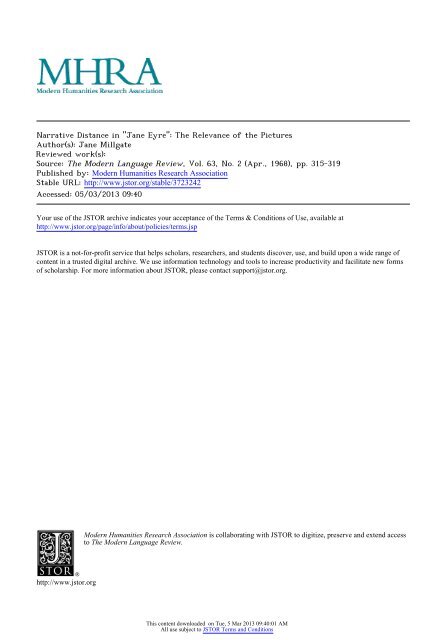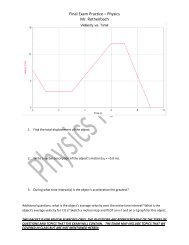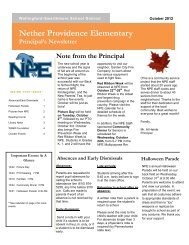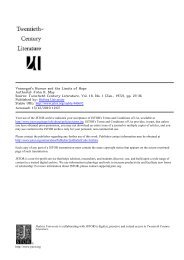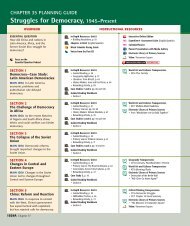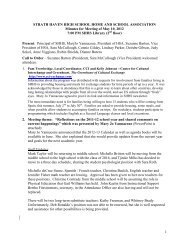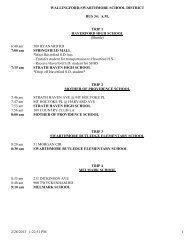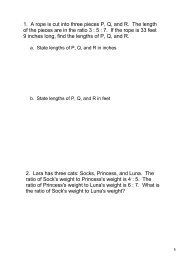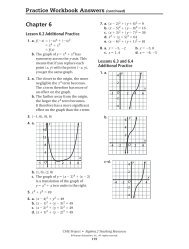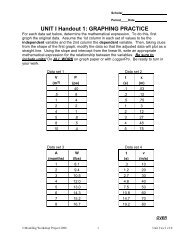Narrative Distance in "Jane Eyre": The Relevance of the Pictures
Narrative Distance in "Jane Eyre": The Relevance of the Pictures
Narrative Distance in "Jane Eyre": The Relevance of the Pictures
You also want an ePaper? Increase the reach of your titles
YUMPU automatically turns print PDFs into web optimized ePapers that Google loves.
<strong>Narrative</strong> <strong>Distance</strong> <strong>in</strong> "<strong>Jane</strong> Eyre": <strong>The</strong> <strong>Relevance</strong> <strong>of</strong> <strong>the</strong> <strong>Pictures</strong>Author(s): <strong>Jane</strong> MillgateReviewed work(s):Source: <strong>The</strong> Modern Language Review, Vol. 63, No. 2 (Apr., 1968), pp. 315-319Published by: Modern Humanities Research AssociationStable URL: http://www.jstor.org/stable/3723242 .Accessed: 05/03/2013 09:40Your use <strong>of</strong> <strong>the</strong> JSTOR archive <strong>in</strong>dicates your acceptance <strong>of</strong> <strong>the</strong> Terms & Conditions <strong>of</strong> Use, available at .http://www.jstor.org/page/<strong>in</strong>fo/about/policies/terms.jsp.JSTOR is a not-for-pr<strong>of</strong>it service that helps scholars, researchers, and students discover, use, and build upon a wide range <strong>of</strong>content <strong>in</strong> a trusted digital archive. We use <strong>in</strong>formation technology and tools to <strong>in</strong>crease productivity and facilitate new forms<strong>of</strong> scholarship. For more <strong>in</strong>formation about JSTOR, please contact support@jstor.org..Modern Humanities Research Association is collaborat<strong>in</strong>g with JSTOR to digitize, preserve and extend accessto <strong>The</strong> Modern Language Review.http://www.jstor.orgThis content downloaded on Tue, 5 Mar 2013 09:40:01 AMAll use subject to JSTOR Terms and Conditions
NARRATIVE DISTANCE IN 'JANE EYRE':THE RELEVANCE OF THE PICTURES'I have now been married ten years',' <strong>the</strong> narrator <strong>of</strong> <strong>Jane</strong> Eyre tells us <strong>in</strong> <strong>the</strong> f<strong>in</strong>alchapter, and <strong>the</strong> paragraph thus <strong>in</strong>troduced goes on to celebrate <strong>the</strong> unity andperfect happ<strong>in</strong>ess <strong>of</strong> that marriage. It is only at this late po<strong>in</strong>t that <strong>the</strong> narrativeperspective <strong>of</strong> <strong>the</strong> book is precisely def<strong>in</strong>ed as that <strong>of</strong> <strong>the</strong> thirty-year-old MrsRochester, though its distance from <strong>the</strong> action has been implied throughout and<strong>the</strong> contrast between <strong>the</strong> calm comprehension <strong>of</strong> <strong>the</strong> narrator and <strong>the</strong> turmoil <strong>of</strong><strong>the</strong> young <strong>Jane</strong> Eyre is significantly underl<strong>in</strong>ed as early as Chapter Two:What a consternation <strong>of</strong> soul was m<strong>in</strong>e that dreary afternoon! How all my bra<strong>in</strong> was <strong>in</strong>tumult, and all my heart <strong>in</strong> <strong>in</strong>surrection! Yet <strong>in</strong> what darkness, what dense ignorance, was<strong>the</strong> mental battle fought! I could not answer <strong>the</strong> ceaseless <strong>in</strong>ward question - why I thussuffered; now, at <strong>the</strong> distance <strong>of</strong>- I will not say how many years, I see it clearly. (ChapterII; I, I2-13)<strong>The</strong> autobiography <strong>of</strong> <strong>Jane</strong> Eyre shows her advance from 'darkness', 'ignorance',and 'tumult' to <strong>the</strong> serenity <strong>of</strong> <strong>the</strong> f<strong>in</strong>al chapter, and <strong>in</strong> this early <strong>in</strong>dication <strong>of</strong>what is to be <strong>the</strong> ultimate achievement <strong>the</strong> pattern <strong>of</strong> <strong>the</strong> whole book is imaged -as is also <strong>the</strong> strategy by which <strong>the</strong> perspective stemm<strong>in</strong>g from that achievementwill be manipulated. By <strong>the</strong> simple device <strong>of</strong> refus<strong>in</strong>g to say what period has<strong>in</strong>tervened between <strong>the</strong> events and <strong>the</strong>ir narration Charlotte Bronte evades <strong>the</strong>obligation to ma<strong>in</strong>ta<strong>in</strong> a constant narrative distance; at <strong>the</strong> same time she reta<strong>in</strong>s<strong>the</strong> unify<strong>in</strong>g effect <strong>of</strong> <strong>the</strong> s<strong>in</strong>gle first-person narrator. <strong>The</strong> frequent clos<strong>in</strong>g-up <strong>of</strong><strong>the</strong> distance between narrator and events does not disturb a reader who has nothad <strong>the</strong> <strong>of</strong>ficial perspective <strong>in</strong>sisted upon, and throughout <strong>the</strong> novel <strong>the</strong>re is, <strong>in</strong>fact, a productive tension between <strong>the</strong> judgements <strong>of</strong> thirty and <strong>the</strong> vision <strong>of</strong> tenor eighteen.Episodes are brought <strong>in</strong>to closer range <strong>in</strong> a variety <strong>of</strong> ways: by shifts <strong>in</strong>to <strong>the</strong>present tense; by <strong>the</strong> <strong>in</strong>vocation <strong>of</strong> powerful images <strong>of</strong> universal application <strong>in</strong> aseries <strong>of</strong> polarities (e.g. light and dark, warmth and cold, satisfaction and hunger,liberty and conf<strong>in</strong>ement); by <strong>the</strong> use <strong>of</strong> dramatic presentation, with dialoguedirectly transmitted ra<strong>the</strong>r than reported; by soliloquies or present-tense accounts<strong>of</strong> <strong>Jane</strong>'s feel<strong>in</strong>gs at particular moments. All <strong>the</strong>se devices result <strong>in</strong> our see<strong>in</strong>g with<strong>the</strong> eyes <strong>of</strong> <strong>the</strong> girl ra<strong>the</strong>r than <strong>of</strong> <strong>the</strong> woman; <strong>in</strong>dividual passages are heightenedand, more importantly, <strong>the</strong> chang<strong>in</strong>g portrait <strong>of</strong> <strong>Jane</strong> Eyre herself is vividlycreated. We come to know <strong>the</strong> hero<strong>in</strong>e not merely by receiv<strong>in</strong>g narrative<strong>in</strong>formation about <strong>the</strong> events and circumstances which have affected her character,but by shar<strong>in</strong>g her develop<strong>in</strong>g vision <strong>of</strong> <strong>the</strong> world around her.One important way <strong>in</strong> which <strong>Jane</strong>'s vision is given expression <strong>in</strong> <strong>the</strong> novel isthrough <strong>the</strong> description <strong>of</strong> her pictures. <strong>The</strong>se, as outward manifestations <strong>of</strong> heremotional state at particular moments, obviously <strong>of</strong>fer one means, among many,<strong>of</strong> chart<strong>in</strong>g her growth to maturity. It seems possible to argue, however, that <strong>the</strong>yalso assist us <strong>in</strong> dist<strong>in</strong>guish<strong>in</strong>g between <strong>the</strong> shift<strong>in</strong>g narrative perspectives <strong>of</strong> <strong>the</strong>1 Charlotte Bronti, <strong>Jane</strong> Eyre, Shakespeare Head edition, 2 vols. (Oxford, 1931), II, 281. Allsubsequent page references are to this edition and are <strong>in</strong>corporated <strong>in</strong>to <strong>the</strong> text.This content downloaded on Tue, 5 Mar 2013 09:40:01 AMAll use subject to JSTOR Terms and Conditions
316 <strong>Narrative</strong> <strong>Distance</strong> <strong>in</strong> '<strong>Jane</strong> Eyre'novel by provid<strong>in</strong>g an <strong>in</strong>strument for measur<strong>in</strong>g <strong>the</strong> angle and coloration <strong>of</strong> <strong>the</strong>narrative at a given po<strong>in</strong>t.When Bessie Leven visits Lowood her practical m<strong>in</strong>d is impressed by <strong>the</strong> picturewhich <strong>Jane</strong> has pa<strong>in</strong>ted for <strong>the</strong> school super<strong>in</strong>tendent:"Well, that is beautiful, Miss <strong>Jane</strong>! It is as f<strong>in</strong>e a picture as any Miss Reed's draw<strong>in</strong>g-mastercould pa<strong>in</strong>t, let alone <strong>the</strong> young ladies <strong>the</strong>mselves; who could not come near it: and haveyou learnt French?" (Chapter x; I, 115)'Miss <strong>Jane</strong>' now possesses <strong>the</strong> accomplishments <strong>of</strong> a lady, and to a degree whichwill ensure her economic <strong>in</strong>dependence as a teacher. <strong>The</strong> picture Bessie sees isnot described; it has no significance for <strong>Jane</strong> o<strong>the</strong>r than as a social gesture, and <strong>in</strong><strong>the</strong> structure <strong>of</strong> <strong>the</strong> novel it functions simply as a milestone on her advance to<strong>in</strong>dependence. <strong>The</strong> first direct view we have <strong>of</strong> a more personal form <strong>of</strong> expressionis <strong>in</strong> <strong>the</strong> description <strong>of</strong> <strong>the</strong> three pictures which Rochester picks out from <strong>Jane</strong>'sportfolio. As has <strong>of</strong>ten been remarked, <strong>the</strong>se are highly Romantic <strong>in</strong> tone andsubject matter, and play a premonitory role <strong>in</strong> <strong>the</strong> overall pattern <strong>of</strong> <strong>the</strong> novel.Although <strong>Jane</strong> <strong>in</strong>sists that <strong>the</strong>ir subjects appeared before her 'spiritual eye' (I, I59),and that each pa<strong>in</strong>t<strong>in</strong>g is a direct if'pale portrait' (i, I59) <strong>of</strong> that vision, <strong>the</strong> sources<strong>of</strong> <strong>the</strong> pr<strong>in</strong>cipal images are quite clearly literary: this is most obviously true <strong>of</strong> <strong>the</strong>third picture, a strange mixture <strong>of</strong> Milton and Bewick, but all three conta<strong>in</strong>features common to <strong>the</strong> magaz<strong>in</strong>es and 'keepsake' volumes <strong>of</strong> <strong>the</strong> early n<strong>in</strong>eteenthcentury. Even though Rochester is impressed by <strong>the</strong>ir be<strong>in</strong>g 'for a school girl,peculiar' (I, 161), <strong>the</strong> reader f<strong>in</strong>ds <strong>the</strong>ir portentousness, lack <strong>of</strong> orig<strong>in</strong>ality, andnaivety somewhat embarrass<strong>in</strong>g - and this cannot be dismissed simply as a modernreaction.<strong>The</strong> temptations <strong>of</strong> a biographical <strong>in</strong>terpretation are very great at this po<strong>in</strong>t.S<strong>in</strong>ce Rochester is impressed, perhaps Charlotte Bronte means <strong>the</strong> reader to beimpressed: after all, she herself had artistic pretensions and ru<strong>in</strong>ed her eyesight,ironically enough, <strong>in</strong> copy<strong>in</strong>g engrav<strong>in</strong>gs.' But to look to <strong>the</strong> author's biographyfor aid <strong>in</strong> <strong>in</strong>terpretation is to move away from <strong>the</strong> novel itself; it is also, <strong>in</strong> this<strong>in</strong>stance, to assign undue importance to <strong>Jane</strong>'s pictures, to see <strong>the</strong>m as ends ra<strong>the</strong>rthan as means. If biographical <strong>in</strong>terpretation is relevant here, it is so <strong>in</strong> relationnot to Charlotte Bronte but to <strong>the</strong> eighteen-year-old <strong>Jane</strong> Eyre: whereas <strong>the</strong>super<strong>in</strong>tendent's picture <strong>in</strong>dicated accomplishments with social and economicvalue, <strong>the</strong>se pictures reveal <strong>Jane</strong>'s emotional status. Clearly, she has made littleprogress here; <strong>the</strong> pictures speak all too pla<strong>in</strong>ly <strong>of</strong> <strong>the</strong> conditions <strong>of</strong> isolation <strong>in</strong>which <strong>the</strong>y were produced and <strong>of</strong> that unhealthy fasc<strong>in</strong>ation with <strong>the</strong> dismal whichwas both product and curse <strong>of</strong> <strong>Jane</strong>'s affection-starved childhood. <strong>The</strong> experience<strong>of</strong> <strong>the</strong> lonely schoolgirl artist is still pa<strong>in</strong>fully narrow and she must go to literarysources for most <strong>of</strong> her images, so that she differs from <strong>the</strong> rejected child <strong>of</strong> <strong>the</strong>1 For relevant comments on Charlotte Bronte's attitude to art as revealed <strong>in</strong> <strong>Jane</strong> Eyre, see RobertBernard Mart<strong>in</strong>, <strong>The</strong> Accents <strong>of</strong> Persuasion: Charlotte Bronte's Novels (I966), pp. io6-7; Pr<strong>of</strong>essorMart<strong>in</strong> does not attempt to force on <strong>the</strong> pictures a limited autobiographical <strong>in</strong>terpretation. Incontrast, Lawrence E. Moser, S.J., 'From Portrait to Person: A Note on <strong>the</strong> Surrealistic <strong>in</strong> <strong>Jane</strong>Eyre', N<strong>in</strong>eteenth-century Fiction, 20 (1965), 275-8I, while protest<strong>in</strong>g no fear <strong>of</strong> <strong>the</strong> biographicalfallacy, seems never<strong>the</strong>less to fall a victim to it <strong>in</strong> his somewhat arbitrary <strong>in</strong>terpretations <strong>of</strong> <strong>the</strong>three pictures Rochester selects from <strong>Jane</strong>'s portfolio; no discussion <strong>of</strong> <strong>the</strong> o<strong>the</strong>r pictures is <strong>of</strong>feredand <strong>the</strong> article, despite its confident handl<strong>in</strong>g <strong>of</strong> biographical material, unaccountably refers toCharlotte as <strong>the</strong> youngest <strong>of</strong> <strong>the</strong> Bronte sisters.This content downloaded on Tue, 5 Mar 2013 09:40:01 AMAll use subject to JSTOR Terms and Conditions
JANE MILLGATE 317open<strong>in</strong>g chapter only <strong>in</strong> be<strong>in</strong>g able to project images <strong>of</strong> ler plight <strong>in</strong>stead <strong>of</strong> merelyabsorb<strong>in</strong>g <strong>the</strong>m <strong>in</strong> passivity.<strong>The</strong> central Thornfield episodes <strong>of</strong> <strong>the</strong> novel are presented largely <strong>in</strong> terms <strong>of</strong><strong>the</strong> same vision which produced <strong>the</strong> pictures, and <strong>the</strong> latter thus provide an earlyclue by which <strong>the</strong> emotional coloration <strong>of</strong> those episodes - <strong>in</strong>clud<strong>in</strong>g <strong>the</strong> highlyRomantic depiction <strong>of</strong> Rochester - can be discerned and properly evaluated.<strong>The</strong> way <strong>Jane</strong>'s creative imag<strong>in</strong>ation goes to work on its materials is quite preciselyrevealed <strong>in</strong> <strong>the</strong> genesis <strong>of</strong> <strong>the</strong> pictures she actually completes while at Thornfield,those contrast<strong>in</strong>g portraits <strong>of</strong> 'a Governess, disconnected, poor, and pla<strong>in</strong>' and <strong>of</strong>'Blanche, an accomplished lady <strong>of</strong> rank' (I, 206) which she <strong>in</strong>tends as medic<strong>in</strong>efor a m<strong>in</strong>d which love <strong>of</strong> Rochester has <strong>in</strong>fected with wishful th<strong>in</strong>k<strong>in</strong>g. <strong>The</strong>picture <strong>of</strong> Blanche is taken not from life but from a description <strong>of</strong> Mrs Fairfax's:"Tall, f<strong>in</strong>e bust, slop<strong>in</strong>g shoulders; long, graceful neck: olive complexion, dark and clear;noble features; eyes ra<strong>the</strong>r like Mr Rochester's: large and black, and as brilliant as herjewels. And <strong>the</strong>n she had such a f<strong>in</strong>e head <strong>of</strong> hair; raven-black, and so becom<strong>in</strong>gly arranged:a crown <strong>of</strong> thick plaits beh<strong>in</strong>d, and <strong>in</strong> front <strong>the</strong> longest, <strong>the</strong> glossiest curls I ever saw. Shewas dressed <strong>in</strong> pure white; an amber-coloured scarf was passed over her shoulder andacross her breast, tied at <strong>the</strong> side, and descend<strong>in</strong>g <strong>in</strong> long, fr<strong>in</strong>ged ends below her knee.She wore an amber-coloured flower, too, <strong>in</strong> her hair: it contrasted well with <strong>the</strong> jetty mass<strong>of</strong> her curls." (Chapter xvI; I, 203)This is a factual account whose dramatic and Romantic details are <strong>the</strong> creation<strong>of</strong> <strong>the</strong> figure described and not <strong>of</strong> Mrs Fairfax. But when <strong>Jane</strong> translates thisdescription <strong>in</strong>to <strong>in</strong>structions for her pa<strong>in</strong>t brush she still fur<strong>the</strong>r heightens andromanticizes <strong>the</strong> colours and <strong>the</strong> details: <strong>the</strong> eye becomes 'oriental', <strong>the</strong> neck andbust 'Grecian'; <strong>the</strong>re is now a 'dazzl<strong>in</strong>g' arm, 'diamond r<strong>in</strong>g', and 'gold bracelet';<strong>the</strong> white dress is <strong>of</strong> 'aerial lace and glisten<strong>in</strong>g sat<strong>in</strong>', while <strong>the</strong> rose has changedfrom amber to 'golden' (I, 206).When <strong>the</strong> real Blanche is before her, <strong>Jane</strong> discerns no difference between MrsFairfax's description, her own portrait, and <strong>the</strong> actual woman:As far as person went, she answered po<strong>in</strong>t for po<strong>in</strong>t, both to my picture and Mrs Fairfax'sdescription. <strong>The</strong> noble bust, <strong>the</strong> slop<strong>in</strong>g shoulders, <strong>the</strong> graceful neck, <strong>the</strong> dark eyes andblack r<strong>in</strong>glets were all <strong>the</strong>re... (Chapter xvII; I, 221)This <strong>in</strong>ability to dist<strong>in</strong>guish between actuality and her own imag<strong>in</strong>ative visionaffects <strong>Jane</strong>'s perception <strong>of</strong> all <strong>the</strong> festivities at Thornfield. Outwardly she seemscalm and detached - an isolated observer <strong>in</strong> <strong>the</strong> w<strong>in</strong>dow-seat - but <strong>the</strong> frequentshifts <strong>in</strong>to <strong>the</strong> present tense1 and <strong>the</strong> non-realistic presentation <strong>of</strong> <strong>the</strong> guests asthough <strong>the</strong>y were a vast horde <strong>of</strong> generic types ra<strong>the</strong>r than a few <strong>in</strong>dividuals showa high degree <strong>of</strong> distort<strong>in</strong>g <strong>in</strong>volvement. <strong>The</strong> <strong>in</strong>frequent <strong>in</strong>terventions <strong>of</strong> <strong>the</strong> voice<strong>of</strong> thirty serve only to underl<strong>in</strong>e <strong>the</strong> disastrous loss <strong>of</strong> perspective, and it is quiteclear that - whatever <strong>the</strong> '<strong>of</strong>ficial' narrative viewpo<strong>in</strong>t <strong>of</strong> <strong>the</strong> novel may be - <strong>the</strong>central episodes at Thornfield are presented from an angle which <strong>the</strong> pictureshave already established as literary, somewhat sentimental, and thoroughly naive.Blanche, as we have seen, is a literary product even before she is re-<strong>in</strong>terpretedby <strong>Jane</strong>. Her dress, speech, taste, all exhibit an excessive Byronism, and what wereceive, <strong>in</strong> <strong>the</strong> narrative as <strong>in</strong> <strong>the</strong> pictures, is <strong>the</strong> blend<strong>in</strong>g <strong>of</strong> <strong>Jane</strong>'s conception <strong>of</strong>1 For a full discussion <strong>of</strong> <strong>the</strong> present-tense passages, see Edgar F. Shannon, Jr., '<strong>The</strong> PresentTense <strong>in</strong> <strong>Jane</strong> Eyre', N<strong>in</strong>eteenth-century Fiction, o1 (1955), 141-5.This content downloaded on Tue, 5 Mar 2013 09:40:01 AMAll use subject to JSTOR Terms and Conditions
3I8<strong>Narrative</strong> <strong>Distance</strong> <strong>in</strong> '<strong>Jane</strong> Eyre'Blanche with Blanche's image <strong>of</strong> herself. Precisely <strong>the</strong> same process is at work <strong>in</strong><strong>the</strong> accounts <strong>of</strong> Rochester at this po<strong>in</strong>t <strong>in</strong> <strong>the</strong> novel; what makes him seem somelodramatic is that he is <strong>the</strong> product <strong>of</strong> two literary imag<strong>in</strong>ations, his own and<strong>Jane</strong>'s, both fully understood and controlled by <strong>the</strong> author. Rochester behaves,quite deliberately and self-consciously, like a Byronic hero, tak<strong>in</strong>g up dramaticposes, s<strong>in</strong>g<strong>in</strong>g Corsair songs, act<strong>in</strong>g arbitrarily and <strong>in</strong>scrutably; he talks <strong>of</strong> his past<strong>in</strong> Childe Harold terms; he delights <strong>in</strong> dress<strong>in</strong>g up and play<strong>in</strong>g exotic roles. Whensuch a figure is presented through <strong>the</strong> still more naively Romantic imag<strong>in</strong>ation<strong>of</strong> <strong>the</strong> eighteen-year-old <strong>Jane</strong> Eyre <strong>the</strong> coloration becomes positively violent.<strong>The</strong> validity <strong>of</strong> see<strong>in</strong>g a comb<strong>in</strong>ed creative endeavour at work <strong>in</strong> this centralportion <strong>of</strong> <strong>the</strong> novel is established by <strong>the</strong> next group <strong>of</strong> pictures, whose fairy-taleand Romantic elements have <strong>the</strong>ir orig<strong>in</strong> equally <strong>in</strong> <strong>Jane</strong>'s own wishful th<strong>in</strong>k<strong>in</strong>gand <strong>in</strong> Rochester's literary and fanciful version <strong>of</strong> <strong>the</strong>ir love. While <strong>Jane</strong> is awayat Gateshead she not only sketches Rochester--all <strong>in</strong> heavy black pencil andcomplete with flash<strong>in</strong>g eyes - she also <strong>in</strong>dulges <strong>in</strong>fancy vignettes, represent<strong>in</strong>g any scene that happened momentarily to shape itself <strong>in</strong> <strong>the</strong>ever-shift<strong>in</strong>g kaleidoscope <strong>of</strong> imag<strong>in</strong>ation: a glimpse <strong>of</strong> sea between two rocks; <strong>the</strong> ris<strong>in</strong>gmoon, and a ship cross<strong>in</strong>g its disk; a group <strong>of</strong> reeds and water-flags, and a naiad's head,crowned with lotus-flowers, ris<strong>in</strong>g out <strong>of</strong> <strong>the</strong>m; an elf sitt<strong>in</strong>g <strong>in</strong> a hedge-sparrow's nest, undera wreath <strong>of</strong> hawthorn-bloom. (Chapter xxI; I, 302)<strong>The</strong> seascape has <strong>the</strong> familiar elements present <strong>in</strong> all <strong>the</strong> pictures associated with<strong>Jane</strong>'s <strong>in</strong>ner emotional life, while her yearn<strong>in</strong>gs are symbolically embodied <strong>in</strong> <strong>the</strong>'naiad crowned with Lotus-flowers' ris<strong>in</strong>g beyond what are presumably <strong>the</strong> Reeds<strong>of</strong> Gateshead, and <strong>in</strong> <strong>the</strong> elf, completely at home <strong>in</strong> <strong>the</strong> 'hedge-sparrow's nest' <strong>of</strong>what <strong>the</strong> 'hawthorn-bloom' suggests is Thornfield. Fairy-tale elements clusterround <strong>the</strong> relationship <strong>of</strong><strong>Jane</strong> and Rochester from <strong>the</strong>ir first meet<strong>in</strong>g, but <strong>in</strong> <strong>Jane</strong>'scase <strong>the</strong>y serve ma<strong>in</strong>ly to suggest her closeness to childhood, while her commonsense is constantly assert<strong>in</strong>g itself to brush aside old superstitions and to mockRochester's persistent toy<strong>in</strong>g with images <strong>of</strong> Elf-land. <strong>The</strong> realistic side <strong>of</strong> <strong>Jane</strong>f<strong>in</strong>ds an ally <strong>in</strong> <strong>the</strong> sternly materialistic Adele, who <strong>in</strong>sists that <strong>Jane</strong> is no fairy,and calls Rochester 'un vrai menteur' (11, 37). Never<strong>the</strong>less, Rochester cont<strong>in</strong>uesto play with images drawn from Arabian Nights tales, fairy stories and ballads,and with references to <strong>Jane</strong> as some k<strong>in</strong>d <strong>of</strong> small bird, and no matter how much<strong>Jane</strong> may overtly resist this <strong>in</strong>dulgence <strong>in</strong> fantasy, her Gateshead vignettes revealhow completely her imag<strong>in</strong>ation has been ensnared.<strong>The</strong> responsibility for <strong>the</strong> evasion <strong>in</strong>herent <strong>in</strong> <strong>the</strong> creation and cont<strong>in</strong>uation <strong>of</strong>this dream-world thus rests jo<strong>in</strong>tly with <strong>Jane</strong> and with Rochester, both <strong>of</strong> <strong>the</strong>mburdened with pasts whose surviv<strong>in</strong>g effects <strong>the</strong>y have not yet seriously confronted.<strong>Jane</strong> f<strong>in</strong>ds images for her day-dreams <strong>in</strong> Rochester's fantastic conversation, and hersense <strong>of</strong> everyday values is no match for her Romantic imag<strong>in</strong>ation and her<strong>in</strong>experience, both <strong>of</strong> which impell her to respond positively to Rochester's Byronicpose. <strong>The</strong> thirty-year-old narrative voice emphasizes <strong>the</strong> moments <strong>of</strong> realism, but<strong>the</strong> struggle between common sense and Romantic sensibility f<strong>in</strong>ds immediateexpression only <strong>in</strong> haunted dreams and <strong>in</strong> stra<strong>in</strong>ed, self-conscious day-timebehaviour which matches <strong>in</strong> its archness <strong>the</strong> artificiality <strong>of</strong> Rochester's desire todeck his bride <strong>in</strong> silks and jewels.<strong>The</strong> flight from Thornfield follow<strong>in</strong>g <strong>the</strong> <strong>in</strong>terrupted marriage ceremony marks<strong>the</strong> turn<strong>in</strong>g-po<strong>in</strong>t for <strong>Jane</strong>, and she undergoes a trial on <strong>the</strong> moors which br<strong>in</strong>gsThis content downloaded on Tue, 5 Mar 2013 09:40:01 AMAll use subject to JSTOR Terms and Conditions
JANE MILLGATE 319lecr f'ace to face with <strong>the</strong> real mean<strong>in</strong>g <strong>of</strong> <strong>the</strong> personal worth and <strong>in</strong>dependence towhich she had somewhat prematurely laid claim. <strong>The</strong> newly-found humility <strong>of</strong><strong>the</strong> schoolmistress <strong>of</strong> Morton shows itself <strong>in</strong> her next pictures, which are <strong>of</strong> ord<strong>in</strong>arysubjects taken from life, one <strong>the</strong> portrait <strong>of</strong> a pupil, o<strong>the</strong>rs 'sundry views from nature,taken <strong>in</strong> <strong>the</strong> Vale <strong>of</strong> Morton and on <strong>the</strong> surround<strong>in</strong>g moors' (II, 172). <strong>The</strong>y arefollowed by <strong>the</strong> portrait <strong>of</strong> Rosamund Oliver - a portrait whose pleasure for <strong>Jane</strong>comes from hav<strong>in</strong>g 'so perfect and radiant a model' (i, I72). <strong>Jane</strong>'s first description<strong>of</strong> Rosamund presents a figure seen entirely from an artist's angle: 'eyes shapedand coloured as we see <strong>the</strong>m <strong>in</strong> lovely pictures', '<strong>the</strong> pencilled brow', '<strong>the</strong> livelierbeauties <strong>of</strong> t<strong>in</strong>t and ray' (ii, I63-4). <strong>The</strong> ease with which this term<strong>in</strong>ology ismanipulated shows a new detachment <strong>in</strong> <strong>Jane</strong>, as well as suggest<strong>in</strong>g a certa<strong>in</strong>superficiality <strong>in</strong> <strong>the</strong> figure she exam<strong>in</strong>es. In <strong>the</strong> actual portrait <strong>the</strong> contrast with <strong>the</strong>picture <strong>of</strong> Blanche is clearly implied: this is a copy from life, not an imag<strong>in</strong>ative<strong>in</strong>terpretation, and it is <strong>in</strong>tended for public display, not private flagellation. <strong>The</strong>fidelity <strong>of</strong> <strong>the</strong> result<strong>in</strong>g likeness is attested not by <strong>Jane</strong> herself, but by Mr Oliverand by <strong>the</strong> startled St John Rivers.<strong>The</strong>re is one fur<strong>the</strong>r stage, and it is marked, significantly enough, by <strong>the</strong> totalcessation <strong>of</strong> <strong>Jane</strong>'s artistic activities. In <strong>the</strong> account <strong>of</strong> <strong>Jane</strong>'s married life <strong>in</strong> <strong>the</strong>f<strong>in</strong>al chapter, all her imag<strong>in</strong>ative activity and pictorial skill are devoted to <strong>the</strong>severely practical yet emotionally satisfy<strong>in</strong>g task <strong>of</strong> embody<strong>in</strong>g <strong>in</strong> words, for <strong>the</strong>benefit <strong>of</strong> her bl<strong>in</strong>d husband, whatever passes immediately before her eyes:He saw nature - he saw books through me; and never did I weary <strong>of</strong> gaz<strong>in</strong>g for his behalf,and <strong>of</strong> putt<strong>in</strong>g <strong>in</strong>to words <strong>the</strong> effect <strong>of</strong> field, tree, town, river, cloud, sunbeam - <strong>of</strong> <strong>the</strong>landscape before us; <strong>of</strong> <strong>the</strong> wea<strong>the</strong>r round us - and impress<strong>in</strong>g by sound on his ear whatlight could no longer stamp on his eye. (Chapter xxxvmII; I, 282)<strong>Jane</strong>'s powers <strong>of</strong> visual realization, far from be<strong>in</strong>g suppressed, now share <strong>in</strong> thatexaltation and fulfilment which her whole be<strong>in</strong>g has found <strong>in</strong> <strong>the</strong> daily demands<strong>of</strong> an altruism from which <strong>the</strong> maturity <strong>of</strong> her love has shorn every h<strong>in</strong>t <strong>of</strong> selfsacrifice.Earlier <strong>in</strong> <strong>the</strong> novel Charlotte Bronte has exploited <strong>the</strong> considerable freedomafforded by <strong>the</strong> first-person convention to manipulate and vary <strong>the</strong> narrativedistance <strong>in</strong> order to achieve her dual purpose <strong>of</strong> depict<strong>in</strong>g both <strong>the</strong> story and <strong>the</strong>personal development <strong>of</strong> <strong>the</strong> story-teller; <strong>in</strong> so do<strong>in</strong>g, as we have seen, she makesfull use <strong>of</strong> <strong>Jane</strong>'s pa<strong>in</strong>t<strong>in</strong>gs to mark clear po<strong>in</strong>ts on <strong>the</strong> scale <strong>of</strong> narrative <strong>in</strong>volvement.Now, <strong>in</strong> <strong>the</strong> last chapter, <strong>the</strong> clos<strong>in</strong>g up <strong>of</strong> <strong>the</strong> gap between <strong>the</strong> narrator and<strong>the</strong> events narrated is co<strong>in</strong>cident with, and dependent upon, a f<strong>in</strong>al <strong>in</strong>tegration <strong>of</strong>all aspects <strong>of</strong> <strong>Jane</strong>'s personality. If <strong>the</strong>re is, at this stage, no fur<strong>the</strong>r mention <strong>of</strong>pa<strong>in</strong>t<strong>in</strong>g or draw<strong>in</strong>g, that is because measurements <strong>of</strong> narrative <strong>in</strong>volvement areno longer required and, equally, because <strong>the</strong> aptitudes and impulses which <strong>Jane</strong>displayed <strong>in</strong> her pictures are now devoted not to compulsive self-expression, noreven to coolly objective portraiture, but to human communication <strong>of</strong> a peculiarly<strong>in</strong>tense and passionate k<strong>in</strong>d. To say that <strong>Jane</strong> Eyre, <strong>the</strong> hero<strong>in</strong>e, merges at last with<strong>Jane</strong> Rochester, <strong>the</strong> narrator, is to make at one and <strong>the</strong> same time a statementabout <strong>the</strong> novel's technique and about <strong>the</strong> novel's mean<strong>in</strong>g. That this should be sois a high tribute to <strong>the</strong> 0 sophistication r<strong>of</strong> Charlotte Bronte's art. J~TORONTO~JANEMILLGATETORONTO21This content downloaded on Tue, 5 Mar 2013 09:40:01 AMAll use subject to JSTOR Terms and Conditions


